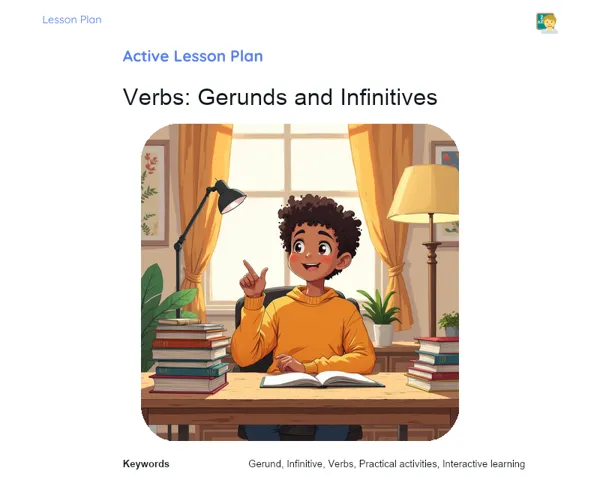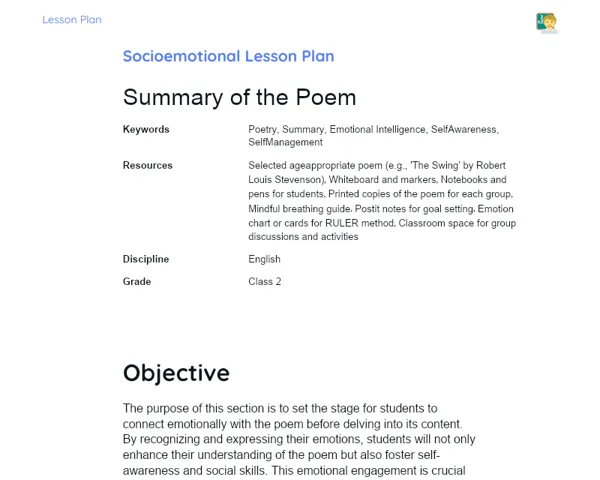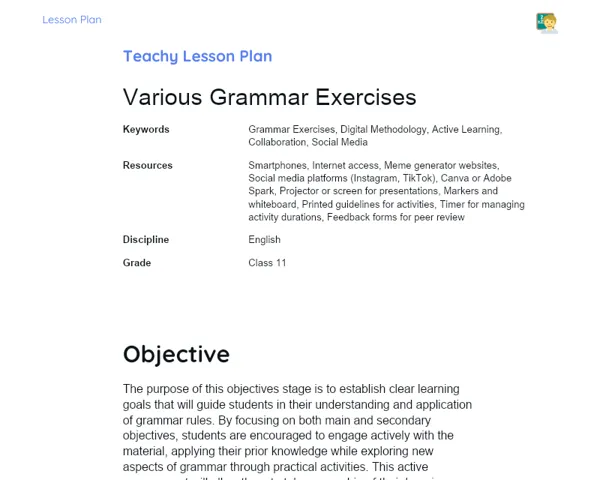Lesson Plan | Lesson Plan Tradisional | Prefixes and Suffixes
| Keywords | Prefixes, Suffixes, Vocabulary, Word Structure, Negation, Repetition, Grammatical Transformation, Practical Examples, Latin, Greek, Written Communication, Spoken Communication |
| Resources | Whiteboard and markers, Projector and computer, Presentation slides, Exercise sheets, Pens and pencils, English dictionaries, Booklets or reference materials on prefixes and suffixes |
Objectives
Duration: 10 - 15 minutes
The aim of this segment of the lesson plan is to provide students with a clear idea of what they will learn during the class. This includes accurately identifying and using the main prefixes and suffixes in English. By establishing these goals, students can focus their attention and efforts on achieving specific and measurable outcomes during the lesson.
Objectives Utama:
1. Learn to identify the key prefixes and suffixes in the English language.
2. Understand how and when to use prefixes and suffixes for correct word formation.
3. Recognize practical examples of words with prefixes and suffixes and their applications in different contexts.
Introduction
Duration: 10 - 15 minutes
The aim of this segment is to engage students from the very beginning and provide a practical context for prefixes and suffixes. This captures students' interest and demonstrates the relevance of the topic in everyday life and their future careers. By recognizing the importance of prefixes and suffixes, students will be more inclined to learn and apply the lesson's content.
Did you know?
Did you know that many prefixes and suffixes in English stem from Latin and Greek? Learning these affixes not only supports one's mastery of English but can also ease the learning of other languages, like Hindi and Tamil. Moreover, in professional settings, the correct application of prefixes and suffixes can significantly improve clarity and precision in both written and spoken communication.
Contextualization
Prefixes and suffixes are important building blocks of the English language. They allow us to create new words, modify the meanings of existing ones, and enhance our understanding of the language's structure. For instance, when we add the prefix 'un-' to the word 'happy', it changes to 'unhappy', indicating the opposite meaning. Likewise, adding the suffix '-ness' to 'happy' gives us 'happiness', turning an adjective into a noun. Grasping these components can greatly enrich students' vocabulary.
Concepts
Duration: 60 - 65 minutes
The aim of this segment of the lesson plan is to enhance students' comprehension of prefixes and suffixes by offering detailed insights and practical examples. This will assist students in recognizing and correctly using these language elements across various contexts, thereby enriching their vocabulary and honing their communication skills in English.
Relevant Topics
1. Common Prefixes:
2. Un-: Indicates negation or opposition. Example: unhappy.
3. Re-: Denotes repetition. Example: redo.
4. Pre-: Means before. Example: preview.
5. Dis-: Indicates negation or opposition. Example: disagree.
6. Mis-: Denotes error or incorrectness. Example: misunderstand.
7. Common Suffixes:
8. -ness: Transforms adjectives into nouns. Example: happiness.
9. -ly: Transforms adjectives into adverbs. Example: quickly.
10. -ful: Indicates fullness or abundance. Example: joyful.
11. -less: Indicates absence or lack. Example: hopeless.
12. -ment: Transforms verbs into nouns. Example: development.
13. Usage Rules:
14. Prefixes: Always added before the root word, maintaining its structure.
15. Suffixes: Added after the root word, potentially changing the grammatical class or meaning.
16. Practical Examples:
17. Prefixes: Unkind, Rebuild, Preorder.
18. Suffixes: Darkness, Beautifully, Fearless.
19. Origin and Evolution:
20. Many prefixes and suffixes in English originate from Latin and Greek, showcasing how these affixes have evolved over time and been influenced by other languages.
To Reinforce Learning
1. 1. Write three examples of words using the prefix 'dis-' and explain their meanings.
2. 2. Transform the words 'happy', 'quick', and 'use' using appropriate suffixes and explain the changes in meaning.
3. 3. Explain the difference between the prefixes 'un-' and 'mis-', providing examples for each.
Feedback
Duration: 15 - 20 minutes
The aim of this stage is to ensure students consolidate what they have learned through a thorough discussion of the resolved questions. This provides students with the opportunity to validate their responses, clear any doubts, and deepen their understanding of prefixes and suffixes. Furthermore, the engagement questions encourage students to reflect on the practical application of the learned material, fostering a more meaningful learning experience.
Diskusi Concepts
1. Discussion of Questions Resolved by Students: 2. 1. Write three examples of words using the prefix 'dis-' and explain their meaning. 3. - Dislike: Not liking. Example: 'I dislike broccoli.' 4. - Disappear: To vanish. Example: 'The magician made the rabbit disappear.' 5. - Disconnect: To unhook. Example: 'Please disconnect the charger.' 6. 2. Transform the words 'happy', 'quick', and 'use' using appropriate suffixes and explain the changes in meaning. 7. - Happy + -ness = Happiness: The state of being joyful. Example: 'Her happiness is contagious.' 8. - Quick + -ly = Quickly: In a swift manner. Example: 'He finished his homework quickly.' 9. - Use + -ful = Useful: Full of utility. Example: 'This tool is very useful.' 10. 3. Explain the difference between the prefixes 'un-' and 'mis-' providing examples for each. 11. - Un- signifies negation or the opposite. For example, 'Unhappy' indicates not happy. 12. - Mis- denotes error or incorrectness. For example, 'Misunderstand' means to comprehend incorrectly.
Engaging Students
1. Questions and Reflections to Engage Students: 2. 1. What difference does it make in meaning when using a prefix versus a suffix to form new words? 3. 2. How can understanding prefixes and suffixes assist in reading and comprehending complex texts? 4. 3. Can you think of other words that employ the prefixes and suffixes discussed today? Can you identify the meanings of these affixes in new words? 5. 4. How might knowledge of prefixes and suffixes be beneficial in your future career?
Conclusion
Duration: 10 - 15 minutes
The aim of this segment is to consolidate students’ learning by summarizing the main points covered and reinforcing the practical significance of the acquired knowledge. This conclusion serves to solidify concepts and underscore the relevance of the topic to students’ everyday lives, promoting a more meaningful and enduring learning experience.
Summary
['Prefixes are added before the root of a word, while suffixes are added after.', 'Common prefixes include: Un- (negation), Re- (repetition), Pre- (before), Dis- (negation), Mis- (error).', 'Common suffixes include: -ness (transforms adjectives into nouns), -ly (transforms adjectives into adverbs), -ful (signifies fullness), -less (indicates absence), -ment (transforms verbs into nouns).', 'Practical examples of words with prefixes: Unkind, Rebuild, Preorder.', 'Practical examples of words with suffixes: Darkness, Beautifully, Fearless.', 'The origins of many prefixes and suffixes in English are rooted in Latin and Greek.']
Connection
Throughout the lesson, the theoretical aspects of prefixes and suffixes were linked to practical applications through real-life examples and problem-solving exercises. Students had the chance to apply the concepts discussed in practical situations, facilitating their understanding and retention of the new information.
Theme Relevance
Understanding prefixes and suffixes is crucial for enhancing vocabulary and improving precision in communication, both written and spoken. Additionally, familiarity with these linguistic elements can aid in learning other languages and assist in interpreting complex texts, both of which are invaluable skills in academic and professional environments.



